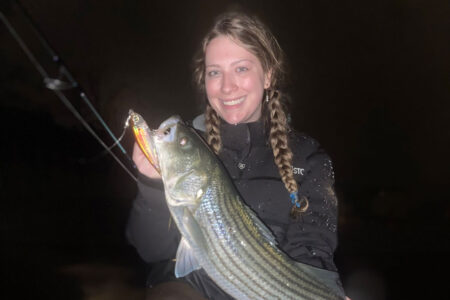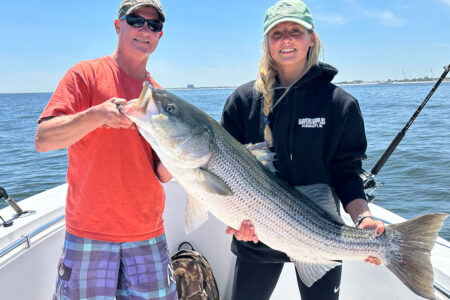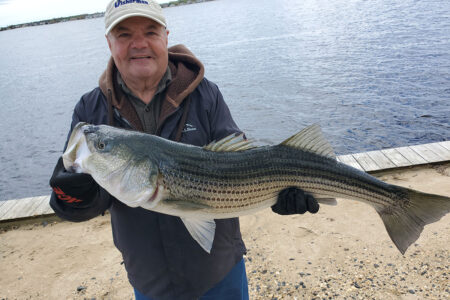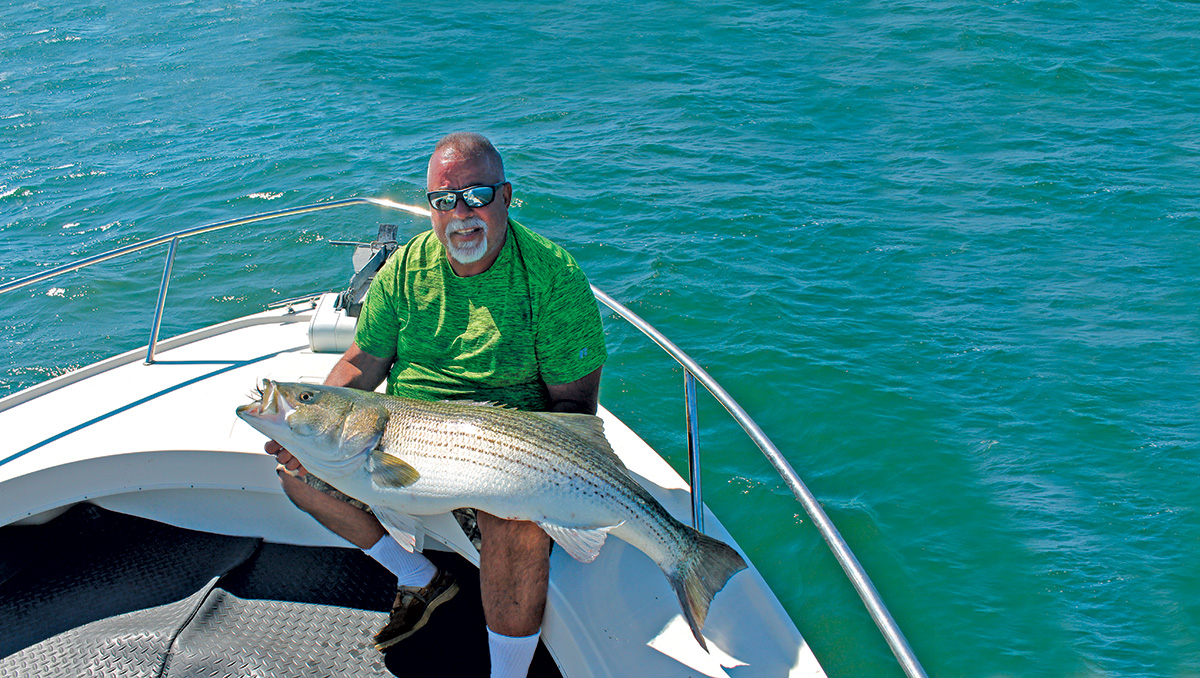
Light tackle can be equally as effective in the deep and turbulent waters of the Striper Coast as it is in the more placid waters of our bays and sounds.
Innovations in tackle over the last decade have dramatically changed the way we fish, and there is no better example of that than the ability to use downsized tackle to land big fish in situations you never would have thought possible even 10 years ago. Despite these advances in tackle, many anglers continue to fish with unnecessarily heavy tackle when targeting inshore species like stripers, especially when it comes to deep water and areas with strong currents and boiling rips. Regardless of the type of fishing in question, it has been proven many times over that employing lighter tackle than is traditionally used for a particular type of fishing will improve your catch, and sometimes dramatically outfish the heavier gear.
The old argument that you should use heavy tackle to not wear out a fish targeted for release no longer holds any water. Braided lines and carbon fiber rods allow you to put tremendous pressure on a fish with little risk of breaking providing your drag is set properly. By properly I don’t mean setting it loose enough so the fish can easily run off line. You want to use maximum drag pressure to wear the fish down rather than allowing it to run itself to exhaustion. When I speak on light tackle fishing at clubs and shows I have audience members hold the rod while I pull off line against a socked down drag. Most are amazed at just how much pressure can be put on a 6- to 6-1/2 foot rod better suited to largemouth bass and 10- or 15-pound braid.
Big Girls Too
And because we are talking light tackle does not mean that we are targeting school size stripers. Sure you will catch your share of small stripers when stalking big water areas, but these same waters also draw cow-size stripers that are equally susceptible to light tackle techniques. Just some of the areas along the Striper Coast that provide big fish opportunities on light tackle include Long Island’s South Shore inlets, the Porgy Hump, Great Eastern and Pollock Rip in Montauk, Block Island, Plum Gut, The Race, Monomoy’s rips, Race Point, the backside of Cape Cod, New England’s breachways, and the bass-rich waters around the Elizabeth Islands. To the south, Jersey’s Shrewsbury Rocks, the western edge of the three mile line, and deep water locations in Delaware and Raritan bays are also ripe for tangling with big stripers on light gear.
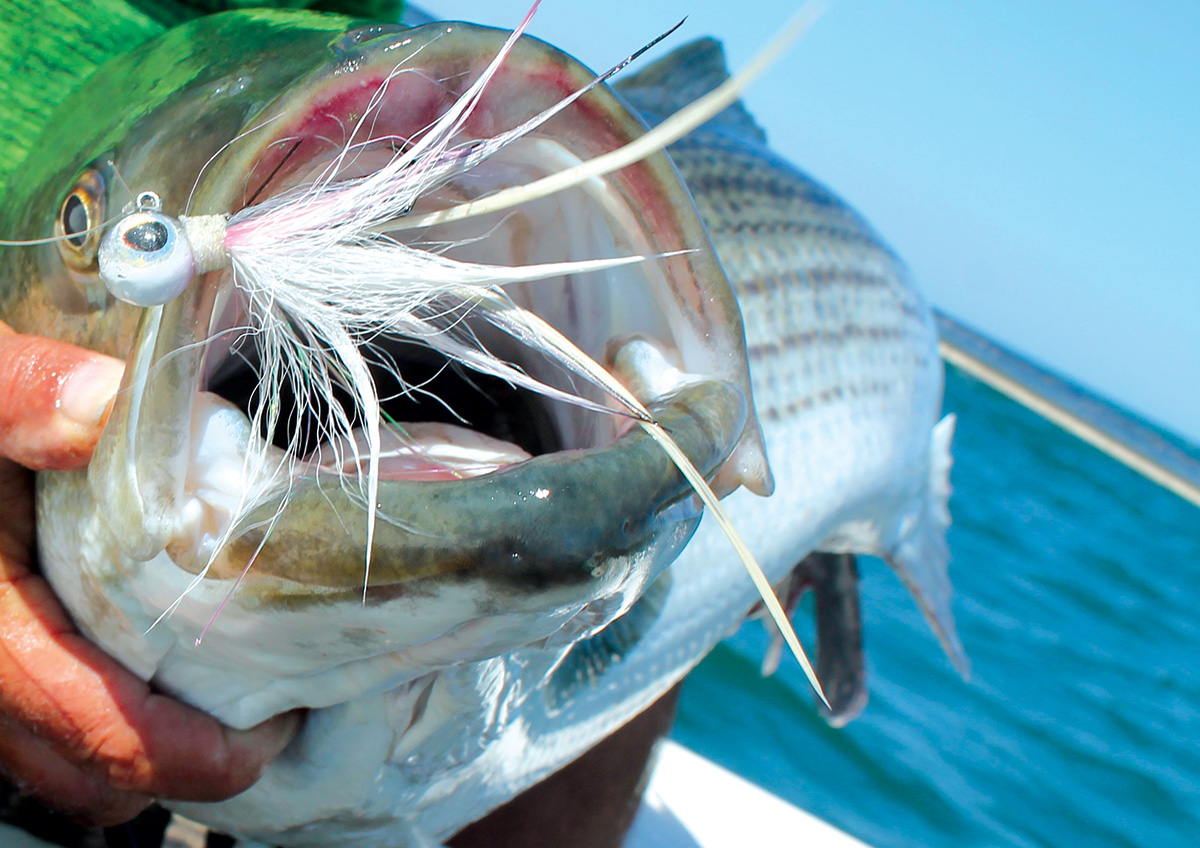
A handful of striper sharpies who work Block Island’s legendary bass waters have adopted relatively light spinning tackle to feed live eels to big bass. Some of the fish they have landed over the years have been especially impressive, particularly a pair of stripers landed by Peter Vican of East Greenwich, Rhode Island. Using spinning tackle with Penn 460 and 560 spinning reels and live eels, he has boated two of the biggest stripers pulled from Rhode Island waters. First it was a 76.88-pound behemoth that set a Rhode Island state record. In 2011, he eclipsed his own record with a cow of 77.40 pounds.
There is a belief among some anglers out there that using the lightest gear possible within reason, is a big advantage over heavier gear and not just in the case of stripers, but on most inshore species from fluke and weakfish, to sea bass and porgies. I have found it to be true for most of the inshore fishing I do and often draw quizzical stares when I climb aboard a boat where most of those onboard are outfitted with “more appropriate” gear. More often than not, the lighter tackle outfishes the heavier gear, often by a wide margin.
Pushing the Limit
Captain John Paduano of Premium Charters pushes the limit on light tackle for big stripers, and it is not because he gets a kick out of catching big fish on feather-weight gear. He has proven 10 times over that light tackle consistently outfishes heavier gear. Using freshwater bass tackle with 3/4- and 1-ounce leadheads or bucktails and outfishing guys using traditional gear drifting three-way rigs and 6 to 10 ounces of lead through Plum Gut and The Race in 80 feet of water is a common occurrence, and the proof is in the catching.
Of course there is more to it than just the light tackle. The snap jigging technique practiced by John is deadly on stripers, and the light tackle lends itself to it. And by the way, catching 30- and 40-pound stripers on this gear is commonplace when the big girls are around, and most of these fish are landed in the same amount of time as fish caught on the heavier tackle. The same scenario has been repeated numerous times in Long Island’s Moriches Inlet where drift after drift produced double hookups while anglers in other boats swimming live baits either went fishless or only hooked an occasional fish.
Captain Scott Leonard of Top Gun Charters on Long Island has built an enviable reputation for catching outsize stripers, winning numerous tournaments along the way, and being featured on the TV show, Monster Fish with Trev Gowdy. During one shoot off of Montauk, several stripers topping the 50-pound mark were landed on live bait. Scott fishes relatively light tackle compared to what most anglers are fishing in those waters, but the difference maker according to the skipper is fishing lighter line. He spools up with 20-pound test and rarely breaks a fish off.
Why So Effective
So what is it about the light tackle and light lines that make a difference in drawing strikes from stripers in big water areas? The same way this tackle is so effective in shallow bays and sounds also applies to deep water and boiling rips. It results in a more natural presentation resulting from the use of lighter lines, greatly reducing water resistance, which allows an angler to fish considerably lighter weights, and in the case of artificials, smaller jigs. At times, the ability to deliver downsized lures effectively can make all the difference in the world, especially when the fish are gorging on small baitfish.
Speak to any very good fisherman, regardless of the type of fishing they do and the one thing they all have in common is “feel.” Having a “feel” for the game can mean maintaining contact with your live bait and knowing when a striper is about to pounce. It’s having a feel for the bottom and being able to keep your lure or bait in the strike zone. It’s being able to bounce a jig or bucktail off of the bottom without getting hung up and responding instantly when a fish mouths your offering on the drop. I will say right off the top that having that feel, or being able to develop that feel is critical to being successful at this game. The deeper the water and the stronger the current, the more difficult it will be for you to succeed. And to be honest, I’ve seen some otherwise pretty good anglers and captains fail miserably at trying to develop this feel.
In addition to developing a feel for the bottom and strikes, there are a couple of things you can do to shorten the learning curve. In deep water, rather than just dropping your jig over the side and allowing it to free fall on its own, Capt. John prefers to use long lifts of the rod to free line from the spool so that there is no resistance to slow its descent. You will reach bottom quicker with less scope to your line, and it will be easy to detect when the lure reaches bottom. Ninety-five percent of the time to be successful, your lure must be bouncing the bottom. You can also gain a little advantage by using hi-vis lines. Sudden changes or movement in your line where it enters the water can help indicate you have hit bottom, or that a fish has mouthed your offering.
Defining Light Tackle
How do we define light tackle? If we are talking about using bucktails or leadheads dressed with soft plastics and weighing anywhere from 1/2 to 1-1/2 ounces, a 6- to 6-1/2 foot spinning rod fitted with a 3000 series reel spooled with 10- or 15-pound braid can be a powerful tool. Choose rods that are fairly stiff all the way to the tip, especially if you are going to be snap jigging so that the jigging action you impart is not lost to a mushy tip section.
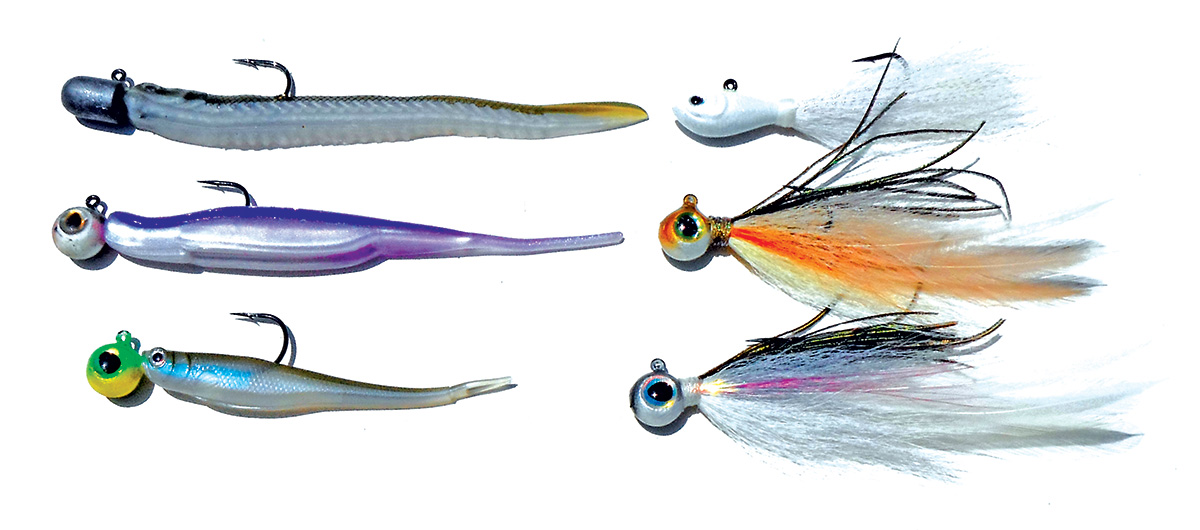
The limitations to how light you can go with your tackle selection is largely dependent on what kind of payloads you are looking to deliver. For fishing live eels, small live baits or diamond jigs weighing more than 1-1/2 ounces, you probably want to step up a 6-1/2 or 7-foot rod rated for 12- to 20-pound test and a 4000 series reel spooled with 20-pound braid. In either case, avoid the temptation of a heavy leader, which will negatively affect the more natural presentation provided by the lighter tackle. I like 20-pound fluorocarbon or pink Ande on the lighter end and 30-pound on the heavier end. This is a far cry from the 60- and 80-pound leaders used by some anglers in these areas.
I don’t know that I can fully explain why light tackle is often so much more efficient, but I do know that in a very lengthy fishing career, I have racked up an extraordinary number of experiences that leave no doubt about the advantages that light tackle has over heavier tackle, even when it comes to catching big stripers in big water.

